List of roof shapes
Roof shapes differ greatly from region to region. The main factors which influence the shape of roofs are the climate and the materials available for roof structure and the outer covering. Roof terminology is also not rigidly defined. Usages vary slightly from region to region, or from one builder or architect to another.
| Wikimedia Commons has media related to Roofs by form. |
Roof shapes vary from almost flat to steeply pitched. They can be arched or domed; a single flat sheet or a complex arrangement of slopes, gables and hips; or truncated (terraced, cut)[1] to minimize the overall height.
Roof shapes
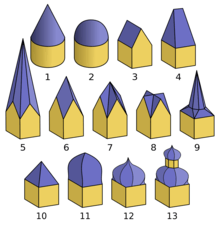
Towers, especially church towers, frequently feature special roof shapes
- Flat: These are found in traditional buildings in regions with a low precipitation. Modern materials which are highly impermeable to water make possible the very large low-pitch roofs found on large commercial buildings. Although referred to as flat they are generally gently pitched.
- Roof terrace (including roof garden): the same with protections from falling such as a balustrade, parapet walls or surrounding raised plant beds used as a living or public dining space.
- Mono-pitched roofs (Pitched here means a roof plane rather than a slope and implies it is not a flat roof)
- Mono-pitched roof (shed, skillion, lean-to roof[2]): A roof with one slope, historically attached to a taller wall.
- Saw-tooth: A roof comprising a mono-pitched roof or for larger buildings, series of, mono-pitched roofs with vertical surfaces glazed and pitched upward in general terms away from the equator, though other directions suit if direct sunlight is desired and where rooftop access may otherwise be impracticable. The roof tops are opaque, shielding traditionally workers and machinery from direct sunlight. This sort of roof commonly admits natural light into a factory, and is also known as "Northlight" in the northern hemisphere implying a single such plane.[3]
- Pent roof (pentice, skirt roof if carried around the house[4]): A roof appended, thus the name, to the wall of a building and by implication having further roofs or terraces above. (See gallery below)
- Multi-pitched roofs:
- Gable (ridged, dual-pitched, peaked, saddle, pack-saddle, saddleback,[5] span roof[6]): A simple roof design shaped like an inverted V.
- Cross gabled: The result of joining two or more gabled roof sections together, forming a T or L shape for the simplest forms, or any number of more complex shapes.
- See also roof pitch, crow-stepped, corbie stepped, stepped gable: A gable roof with its end parapet walls below extended slightly upwards and shaped to resemble steps.
- A-frame
- Half-hipped (clipped gable): A combination of a gable and a hip roof (pitched roof without changes to the walls) with the hipped part at the top and the gable section lower down.
- Dutch gable, gablet: A hybrid of hipped and gable with the gable (wall) at the top and hipped lower down; i.e. the opposite arrangement to the half-hipped roof. Overhanging eaves forming shelter around the building are a consequence where the gable wall is in line with the other walls of the buildings that is unless the upper gable or gables is or are recessed.
- Saltbox, catslide: A gable roof with one side longer than the other, and thus closer to the ground unless the pitch on one side is altered.
- Outshot or catslide: A pitched extension of a main roof similar to a lean-to but an extension of the upper roof.
- Bonnet roof: A reversed gambrel or Mansard roof with the lower portion at a lower pitch than the upper portion.
- Monitor roof: A roof with a monitor; 'a raised structure running part or all of the way along the ridge of a double-pitched roof, with its own roof running parallel with the main roof.'
- Butterfly roof (V-roof,[7] London roof[8]): A V-shaped roof resembling an open book. A kink separates the roof into two parts running towards each other at an obtuse angle.
- Karahafu: A type of gable found in some traditional Japanese buildings.
- Hidden roof: A type of Japanese roof construction.
- Hip, hipped: A hipped roof is sloped in two pairs of directions (e.g. N-S and E-W) compared to the one pair of direction (e.g. N-S or E-W) for a gable roof.
- Half-hipped: A hybrid of a gable and a hipped roof. (See above.)
- Dutch gable, gablet: The reverse hybrid of a hipped and a gable roof. (See above.)
- Cross hipped: The result of joining two or more hip roof sections together, forming a T or L shape for the simplest forms, or any number of more complex shapes.
- Satari: A Swedish variant on the monitor roof; a double hip roof with a short vertical wall usually with small windows, popular from the 17th century on formal buildings. (Säteritak in Swedish.)
- Mansard (French roof): A roof with the pitch divided into a shallow slope above a steeper slope. The steep slope may be curved. An element of the Second Empire architectural style (Mansard style) in the U.S.
- Gambrel, curb, kerb: A roof similar to a mansard but sloped in one direction rather than both.
- Bell-cast (sprocketed, flared): A roof with the shallow slope below the steeper slope at the eaves. Compare with bell roof.
- East Asian hip-and-gable roof
- Mokoshi: A Japanese decorative pent roof
- Pyramidal
- Pyramid roof (pavilion roof): A hip roof on a square building.
- Pyatthat: A multi-tiered and spired roof commonly found in Burmese royal and Buddhist architecture.
- Tented:A type of polygonal hipped roof with steeply pitched slopes rising to a peak
- Helm roof, Rhenish helm: A pyramidal roof with gable ends; often found on church towers.
- Twisted, an extreme display of craftsmanship found on some church towers in France, see gallery below.
- Arched roof
- Barrel, barrel-arched (cradle, wagon): A round roof like a barrel (tunnel) vault.
- Catenary: An arched roof in the form of a catenary curve.
- Bow roof, rainbow,[9] Gothic, Gothic arch, and ship's bottom roof. Historically also called a compass roof.[10]
- Gable (ridged, dual-pitched, peaked, saddle, pack-saddle, saddleback,[5] span roof[6]): A simple roof design shaped like an inverted V.
- Circular
- Bell roof (bell-shaped, ogee, Philibert de l'Orme roof): A bell-shaped roof. Compare with bell-cast eaves. De l'Orme also used bow roofs (see below).
- Domed
- Onion dome or rather an imperial roof
- Bochka roof
- Conical roof or cone roof
- Hyperbolic
Illustrations of common and simple roof shapes
 |
 |
 |
 |
| Flat roof | Mono-pitched roof | Gable roof | Gable roof with catslide |
 |
 |
 |
 |
| Ridged, multi-gable or m-type roof |
Gambrel roof | Clerestory roof | Saw-tooth roof |
 |
 |
 |
 |
| Hip roof | Half-hip roof | Tented or pavilion roof | Gablet roof or Dutch gable example with recessed (upper) gable and eaves |
 |
 |
 |
 |
| Rhombic roof | Rainbow roof | Barrel roof | Bow roof |
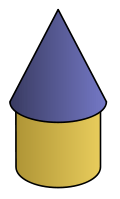 |
.jpg) |
 |
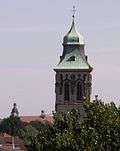 |
| Conical roof | Spire | Onion dome | Welsh spire |
 |
 |
 | |
| Gable roof with eaves | Cross-gabled building with squatter projecting wing and T-shaped plan |
Hip and pent hip roof (Brit: hipped) |
Butterfly roof or trough roof (rare) |
 | |||
| Prow or "flying" Gable roof |
Selection criteria
- Location
- Economics
- Building plan
- Neighbouring buildings
- Building geometry
- Architectural reasons
- Roof shapes
 Arched roof, also called a Gothic arch, rainbow, and ship's bottom roof.
Arched roof, also called a Gothic arch, rainbow, and ship's bottom roof. A bonnet roof with the lower slopes at a lower pitch. This roof form is a classic on some barns in the western United States.
A bonnet roof with the lower slopes at a lower pitch. This roof form is a classic on some barns in the western United States. Catenary curved roof.
Catenary curved roof.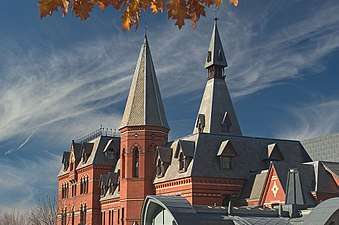
 Flat roof. Western Australia.
Flat roof. Western Australia. Mansard roof on a county jail. Mount Gilead, Ohio.
Mansard roof on a county jail. Mount Gilead, Ohio. A helm roof on the two towers.
A helm roof on the two towers. Gable roof with eaves, exposed, decorated rafters and soffits and stepped (incrementally ascending apexes). Curvy white stenciled bargeboard and artistic gilt gable end. To temple in Chang Mai, Thailand.
Gable roof with eaves, exposed, decorated rafters and soffits and stepped (incrementally ascending apexes). Curvy white stenciled bargeboard and artistic gilt gable end. To temple in Chang Mai, Thailand.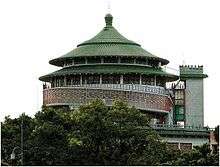 Conical Chinese roof. Nanhai Academy, Taipei.
Conical Chinese roof. Nanhai Academy, Taipei. A conical dry-stone roof on a Trullo hut.
A conical dry-stone roof on a Trullo hut..png) Basic mansard roof. Features classic dormer windows.
Basic mansard roof. Features classic dormer windows.- Curved form of a mansard roof with bell-cast eaves. Rommersdorf Abbey, Germany.
 A common form of gambrel roof. Captain Joseph Atwood house, 1752; now part of the Atwood House Museum, Chatham, Massachusetts, US.
A common form of gambrel roof. Captain Joseph Atwood house, 1752; now part of the Atwood House Museum, Chatham, Massachusetts, US.- A less common form of gambrel roof with a curved lower roof slope with supporting curved soffits and thick tiles. Altnau, Switzerland.
 An ogee roof. (A roof shape following an ogee curve. In this example the roof follows an ogee along both axes.) Montacute Lodge, England. Image by Symon Parsley.
An ogee roof. (A roof shape following an ogee curve. In this example the roof follows an ogee along both axes.) Montacute Lodge, England. Image by Symon Parsley.- South Korean Woljeongsa Octagonal Nine Story Pagoda. Note the typical Asian concave roof shape in the background, with roof corners higher than the sides.
 A form of pyramid roof with a chimney exiting the peak. The Round House, Finchingfield, Essex, England. Image by Robert Edwards.
A form of pyramid roof with a chimney exiting the peak. The Round House, Finchingfield, Essex, England. Image by Robert Edwards. Beehive roof. This is a traditional roof form. Syria.
Beehive roof. This is a traditional roof form. Syria. A pent roof is a smaller roof attached to a wall.
A pent roof is a smaller roof attached to a wall.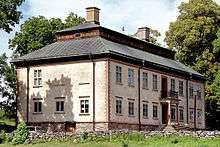 A Swedish Sateri roof (Säteritak in Swedish) is hipped and pent-hipped with two layers of eaves
A Swedish Sateri roof (Säteritak in Swedish) is hipped and pent-hipped with two layers of eaves- Rounded pyramidal roof on a charchala style temple in India.
 A twisted church tower roof.
A twisted church tower roof.
gollark: I mostly get my reds via catching CB kindofrares and trading them for large groups of red hatchlings.
gollark: "What doesn't kill you makes you undead"
gollark: The dragon is, ironically, ded.
gollark: `What Doesn't Kill You` is unfortunately taken.
gollark: As opposed to dying?
See also
- Roof
- List of commercially available roofing material
- Building construction
- Building insulation
- Building envelope
- Stupa
- Green roof: A roof with plantings to be more environmentally friendly, may be any form.
References
- Long, George. "Roof". The Penny cyclopaedia of the Society for the Diffusion of Useful Knowledge. London: Charles Knight, 18331843. 143. Print.
- Cowan, Henry J., and Peter R. Smith. "Shed roof" Dictionary of architectural and building technology. London: Elsevier Applied Science Publishers; 1986. 272. Print.
- "The Machine Shop and the Works. Modern Principles of Design", The Times: Engineering Supplement, London, November 13, 1912, p.25.
- Harris, Cyril M.. "Pent roof". Harris dictionary of architecture & construction. 3rd ed. New York: McGraw-Hill, 2000. Print.
- Fleming, Honour, & Pevsner, A Dictionary of Architecture
- Passmore, Augustine C.. "Span Roof". Handbook of technical terms used in architecture and building and their allied trades and subjects, . London: Scott, Greenwood, and Co.;, 1904. 325. Print.
- Passmore, Augustine C.. "V Roof" Handbook of technical terms used in architecture and building and their allied trades and subjects, . London: Scott, Greenwood, and Co.;, 1904. 362. Print.
- Coutts, John. Loft Conversions. 2nd ed. New York: Wiley, 2012. Print.
- Davies, Nikolas, and Erkki Jokiniemi. Dictionary of architecture and building construction. Amsterdam: Elsevier/Architectural Press, 2008.304
- "Rainbow roof | Article about rainbow roof by The Free Dictionary". encyclopedia2.thefreedictionary.com. Retrieved 2018-10-26.
| Wikimedia Commons has media related to Roofs. |
This article is issued from Wikipedia. The text is licensed under Creative Commons - Attribution - Sharealike. Additional terms may apply for the media files.